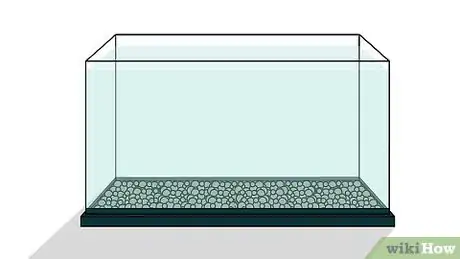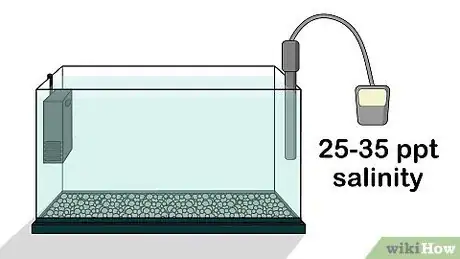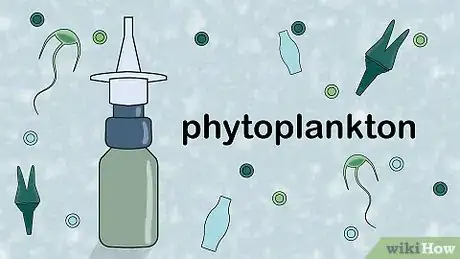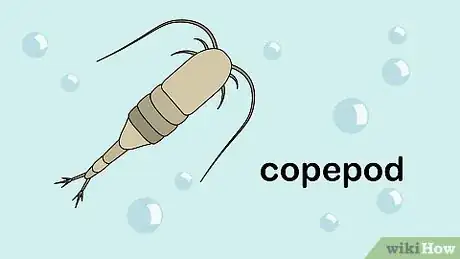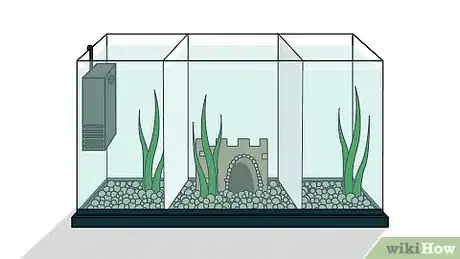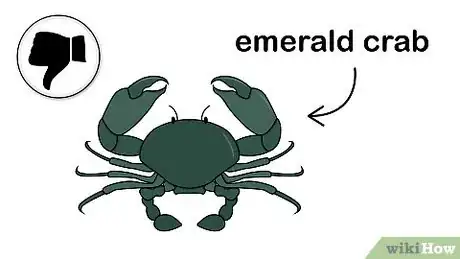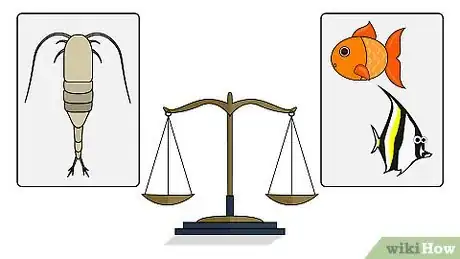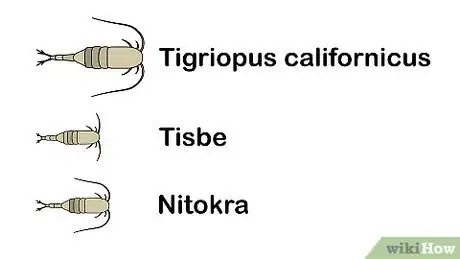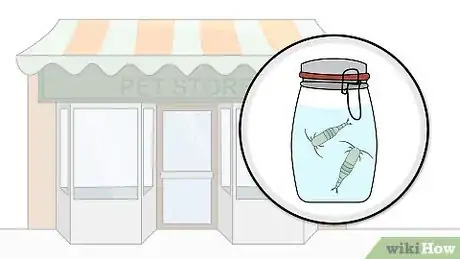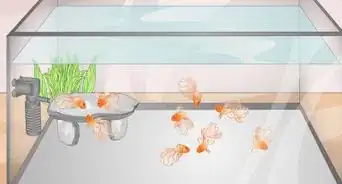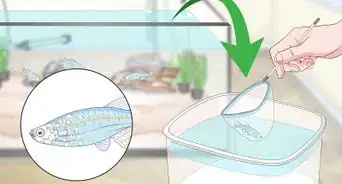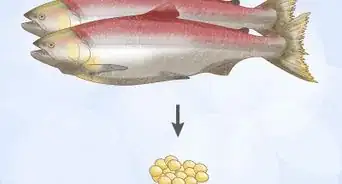This article was co-authored by wikiHow Staff. Our trained team of editors and researchers validate articles for accuracy and comprehensiveness. wikiHow's Content Management Team carefully monitors the work from our editorial staff to ensure that each article is backed by trusted research and meets our high quality standards.
There are 7 references cited in this article, which can be found at the bottom of the page.
wikiHow marks an article as reader-approved once it receives enough positive feedback. In this case, 96% of readers who voted found the article helpful, earning it our reader-approved status.
This article has been viewed 88,861 times.
Learn more...
Copepods are tiny crustaceans. These little critters are important food sources for certain types of marine fish and filter feeders. In fact, they are the only food that some species of fish will eat! Growing your own copepods at home may seem a little intimidating, but fear not--these guys are super hardy. First, choose the appropriate species of copepod for your aquarium’s needs. It’s best to grow your copepods in a separate culturing container, but you can grow them in your main tank using a refugium, too.
Steps
Growing Copepods in a Culturing Container
-
1Purchase an aquarium or small container. The best way to grow copepods is in a separate culturing container.[1] Copepods prefer large containers, so an aquarium is ideal. However, if you don’t have room for another aquarium, no worries. You can also use a small container, like a Rubbermaid plastic jar.
-
2Keep your copepod container at room temperature. Copepods are pretty hardy, but you should avoid temperature extremes. This means it may not be the best idea to keep your container in direct sunlight in July or in the drafty, uninsulated attic in winter. Pick a room in your house that you maintain at a moderate temperature.[4]Advertisement
-
3Adjust the airflow. Gentle aeration will help keep your copepods happy and healthy. Buy an air pump and attach it to a gang valve using rigid air tubing. Place the end of the tube in the water, and use the gang valve to adjust the airflow into the tank or container. It should be flowing at a rate of one bubble every three seconds.[5]
- If you’re using a small container, drill a hole into the lid to allow the the tubing to pass through.
-
4Maintain the proper salinity. Keep the salinity of your tank around 25-35ppt (1.018-1.025+).[6] You can measure salinity using a number of different tools, including refractometers, hydrometers, and conductivity probes. Follow directions on the packaging for an accurate measurement.
- It’s best to keep your culturing container at the same salinity as your main tank. That way, when you feed your copepods to your fish or coral, the copepods won’t go into shock.[7]
-
5Select a phytoplankton to feed your copepods. Copepods eat phytoplankton, a teeny tiny marine algae. Check to see what type of phytoplankton is best for your species of copepod. You can buy phytoplankton at your local fish store or order it online.[8]
- Nannochloropsis is a common phytoplankton that’s pretty easy to find.
-
6Add a few drops of phytoplankton to your container. Add phytoplankton, drop by drop, until the water turns a nice light green color. As the copepods eat the phytoplankton, the water will turn lighter. Your goal is to keep the water light green.[9]
- You may be tempted to clean up the “gunk” that collects at the bottom of your tank, but leave it until you do your monthly cleaning. It’s completely normal, and actually healthy for copepods![10]
-
7Add the copepods to the container. Finally, it’s time to add the key ingredient to your culturing container: your copepods! Allow your copepods to reach room temperature before dumping them in.[11]
- Don’t worry too much about acclimation. These guys are tough!
-
8Harvest your copepods. When it’s time to feed your copepods to your fish or coral, take a cupful of water from your culturing container. Then, pour the water over a 100 micron screen. This will catch the adult copepods while letting the little guys go. Use some salt water to wash the copepods from the screen into a new container, and add them to your main tank.[12]
- Wait a week in between harvests to allow the adult population to regrow.
-
9Change the water regularly. Drain the water over a 55 micron fine mesh screen to collected the copepods, and then place the screen in a clean, saltwater-filled container so they don’t dry up. Wipe the tank down with paper towel, rinse it out with a bit of fresh water, then add clean, fresh saltwater to the tank. Finally, add your copepods and fresh phytoplankton.[13]
- If you’re using a tank, you should change the water every four weeks.
- Change the water weekly for a small culturing container, like a jar or a large cup.
-
10Keep an eye out for contaminants. Sometimes, your copepod culture may become contaminated with other organisms, like ciliates, rotifers and brine shrimp. If this happens, you may need to start a new culture. The contaminants can scarf down all of the copepods’ food, eventually killing off the population.[14]
Growing Copepods in a Refugium
-
1Get a refugium. A refugium is an area that shares water with the main tank but is partially separated to protect small or delicate organisms, like your little copepods. There are several different types of refugiums, so talk to an employee at your local fish store to find one that works with your price point and aquarium size.[15]
- An in-tank refugium is the simplest and cheapest type. It’s a small container that allows water to flow through but keeps bigger critters, like fish, out.
- A hang-on refugium is a separate container that hangs off the back of the main tank, while a sump-based refugium is a second tank that is placed under your main tank.
-
2Set up the refugium with a habitat for the copepods. Add live rock, sand, and macroalgae like ulva to give the copepods food sources and areas to hide and breed. All of these items are available at local saltwater fish stores.[16]
-
3Remove predators from your refugium. If you have other critters in your refugium, like emerald crabs or bristle worms, they may munch on your copepods, so remove a few of them before starting to grow your copepods.[19]
- If removing predators is too difficult or you simply don’t want to, raise your copepods in a separate container.
-
4Add copepods to your refugium. Let them reach room temperature and dump them into the refugium. Turn off the pumps before you add them so they have a chance to swim away from the fish and filter feeders.[20]
-
5Monitor your fish population. If you’re trying to grow copepods in the same tank as your fish, you’ll need to make sure they’re reproducing faster than they’re being eaten in order to maintain the population. If you have too many copepod-eating fish, it could throw off the balance. Be aware that certain fish species that don’t rely copepods as their main food source, like clown fish and line wrasse, still like to snack on them.[21]
- To see how many copepods are in your tank, shine a light in your tank at night. The copepods will look like tiny white specks swimming towards the light.
- You may also be able to find these little critters behind live rock or collected in tank corners.
Choosing Copepods
-
1Research the type of copepods best for your fish or filter feeders. Copepods are typically used to feed marine fish, like mandarin dragonets and scooter blennies, or filter feeders, like coral. Different organisms feed on different types of copepods, so do your research to make sure you pick the right species.[22]
- Tigriopus californicus is one of the most common species of copepods, and should be used to feed adult fish. These critters are pretty hardy and can survive at high population densities and varying water temperatures.
- Because Tigriopus are a larger species, they should never be used to feed fish larva. They can claw at the larva, causing distress and death.
- Tisbe and Nitokra are best for feeding coral and other filter feeders. They reproduce more quickly than Tigriopus and are smaller, which might make them a little harder to see. Like Tigriopus, they are tough.
-
2Purchase live copepods. You may be able buy bottles of live copepods at your local fish store. Otherwise, order them through online retailers like https://www.LiveAquaria.com or https://www.Algaebarn.com.[23]
-
3Observe how your fish respond to the copepods. Larger copepods like Tigriopus may be too big for some fish to handle. In fact, Tigriopus can sometimes fight their way out of a fish gut using their strong mouthparts![24]
- If this happens, you’ll need to select a smaller species of copepod.
Community Q&A
-
QuestionHow do copepods get from refugium to tank?
 cymbospondylus 846Community AnswerLeave the pumps off for about half an hour to allow the copepods to settle before turning the pumps back on. If your main tank is not already established, you will want to purchase phytoplankton and add a few drops to your refugium.
cymbospondylus 846Community AnswerLeave the pumps off for about half an hour to allow the copepods to settle before turning the pumps back on. If your main tank is not already established, you will want to purchase phytoplankton and add a few drops to your refugium. -
QuestionCan you feed copepods on Tropic Marines pro-coral phyton?
 cymbospondylus 846Community AnswerThis is to feed copepods. It would be better to feed meaty foods that break down fairly quickly in the water column. A good mixture of marine pellet and marine flake fish foods ground up in a mortar and pestle will yield terrific results.
cymbospondylus 846Community AnswerThis is to feed copepods. It would be better to feed meaty foods that break down fairly quickly in the water column. A good mixture of marine pellet and marine flake fish foods ground up in a mortar and pestle will yield terrific results. -
QuestionWe want to grow copepods and other freshwater microscopic life in a 10 gallon molded plastic tank. Chiller maintains 20ºC. Grow light working as we have plant life. Any advice is appreciated.
 cymbospondylus 846Community AnswerTo grow marine copepods, place them alone in a 10-gallon saltwater aquarium. Keep the water salinity between 25-35 ppt. Before you ad d the copepods, add a few drops of phytoplankton to the water, which you can order online or purchase from a local fish store. You want the water to be light green.
cymbospondylus 846Community AnswerTo grow marine copepods, place them alone in a 10-gallon saltwater aquarium. Keep the water salinity between 25-35 ppt. Before you ad d the copepods, add a few drops of phytoplankton to the water, which you can order online or purchase from a local fish store. You want the water to be light green.
References
- ↑ http://www.wetwebmedia.com/ca/volume_5/volume_5_2/copepods.htm
- ↑ http://www.advancedaquarist.com/2003/2/breeder
- ↑ http://www.advancedaquarist.com/2003/2/breeder
- ↑ http://www.advancedaquarist.com/2003/2/breeder
- ↑ http://www.liveaquaria.com/pic/article.cfm?aid=302
- ↑ http://www.liveaquaria.com/pic/article.cfm?aid=302
- ↑ http://www.advancedaquarist.com/2003/2/breeder
- ↑ http://www.advancedaquarist.com/2003/2/breeder
- ↑ https://reefs.com/2017/01/30/copepods-home-guide-part-1-harpaticoids/
- ↑ http://www.advancedaquarist.com/2003/2/breeder
- ↑ http://www.wetwebmedia.com/ca/volume_5/volume_5_2/copepods.htm
- ↑ https://reefs.com/2017/01/30/copepods-home-guide-part-1-harpaticoids/
- ↑ http://www.liveaquaria.com/pic/article.cfm?aid=302
- ↑ http://www.liveaquaria.com/pic/article.cfm?aid=302
- ↑ https://www.ratemyfishtank.com/blog/what-is-a-refugium
- ↑ http://www.liveaquaria.com/product/prod_display.cfm?c=3468+2190+3177&pcatid=3177
- ↑ http://www.wetwebmedia.com/ca/volume_5/volume_5_2/copepods.htm
- ↑ https://www.reefcleaners.org/stocking-the-sump-refugium
- ↑ http://www.wetwebmedia.com/ca/volume_5/volume_5_2/copepods.htm
- ↑ http://www.wetwebmedia.com/ca/volume_5/volume_5_2/copepods.htm
- ↑ http://www.wetwebmedia.com/ca/volume_5/volume_5_2/copepods.htm
- ↑ http://www.wetwebmedia.com/ca/volume_5/volume_5_2/copepods.htm
- ↑ https://reefs.com/2017/01/30/copepods-home-guide-part-1-harpaticoids/
- ↑ http://www.wetwebmedia.com/ca/volume_5/volume_5_2/copepods.htm
About This Article
To grow copepods, place them alone in a 10-gallon saltwater aquarium. Keep the water salinity between 25-35 ppt. Before you add the copepods, add a few drops of phytoplankton to the water, which you can order online or purchase from a local fish store. You want the water to be light green. Allow your copepod container to reach room temperature, then pour them into the aquarium. Change the water in the tank every 4 weeks. To grow copepods in a refugium, read on!
